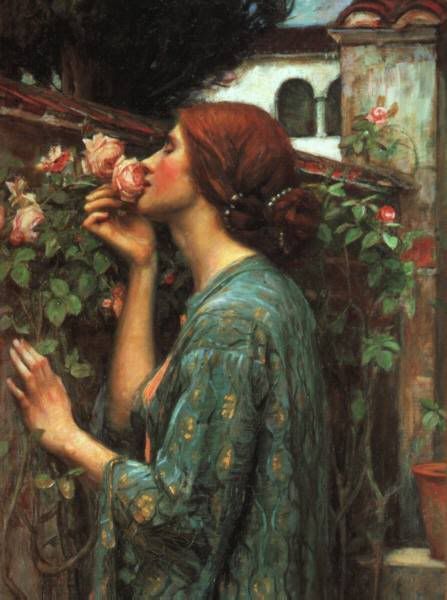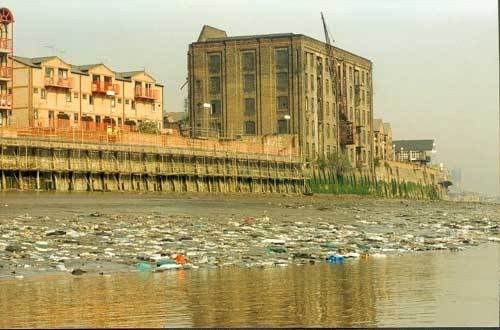
Members of the Pre-Raphaelite Brotherhood, together with many of the artists who took part in the Arts and Crafts movement, had what many today would consider a very simplistic notion of beauty. Their vision is shared today by many traditionalists who will argue emphatically that modern art is devoid of beauty because it is not made up of beautiful elements.
There were three main principles that guided the hands of the Pre-Raphaelite painters. 1. The earnest study of nature (because nature is beautiful). 2. Intensity of feeling (feelings are natural and thus beautiful). 3. Contempt for forumulas in painting (formulas are artificial, and thus ugly).
In keeping with these priciples, the Pre-Raphaelitse painted what they felt were beautiful subjects. For example, the ideas of poets like Chaucer, Dante and Shakespeare were presumed beautiful and thus worthy subjects for paintings. Women were likewise considered to be obviously beautiful, and were often painted in medieval costume (one has only to read a very little of William Morris' writings in order to learn why medieval costume was considered to so beautiful to members of the Arts and Crafts and Pre-Raphaelite movements). The combination of these beautiful ingredients was thought to lead to a beautiful work of art.
I certainly find Pre-Raphaelite art to be beautiful. In many ways it's a refuge from the ugliness that surrounds us. I've noticed over time that while I can appreciate the works of many modern artists, I tend to choose more traditional artwork for our home.
Have you ever seen the film, American Beauty? I have to admit that I loved it, but several professors of mine at University hated it because they saw it as an attack on traditional notions of beauty.
You will recall the scene in which Ricky and Jane watch recorded camcorder footage of plastic bag floating in the wind, which prompts Ricky to remark "sometimes there's just so much beauty in the world that I feel my heart is going to cave in." So--was it, in fact, beautiful? My professors argued that it was most emphatically NOT beautiful. Their logic was quite traditional, and I'm sure William Morris would have agreed with them: Is a plastic bag beautiful? Well, I suppose not. Is a dirty city street beautiful? Um, no. Is garbage floating in the wind beautiful? Definitely not.
John Keats once wrote "beauty is truth, truth beauty. That is all ye know on Earth and all ye need to know." If you take Keats at his word, this can cause some problems. Are pictures of Auschwitz beautiful? Most emphatically not, in my view. Nevertheless, his statement on art has become more or less the maxim for modern art. Most modern art today is concerned with pursuing the "truth" no matter how brutal or ugly it may be. So, while I respect Keats' writing and am a huge fan of his poetry, for the moment I think I'll except the dictionary definition of beauty as the "combination of qualities that make something pleasing and impressive to look at, listen to, touch, smell, or taste." If I accept that definition of beauty, then I think it's fair to say that the plastic bag floating in the wind doesn't exactly add up to a beautiful moment.
Is this beautiful?
So, why does the plastic bag scene always bring tears to my eyes? Maybe the reason I cry during that scene is because I actually feel sorry for Ricky and Jane because that garbage floating in the street is as close as they can get to beauty. What do you think? Is the garbage beautiful? I would love to delve into this issue further in the future.
Wednesday, February 13, 2008
Concept of Beauty in Pre-Raphaelite Art
Posted by
Margaret
at
8:59 AM
![]()
![]()
Labels: philosophy, pre-raphaelites, william morris
Subscribe to:
Post Comments (Atom)


8 comments:
I think you know the answer to your question, because your heart tells you. Morris' rule included human feelings. Keats was also right. It isn't the physical plastic bag, but the debris of life, even its cast-off objects, like the lonely children in the film, or the lost feeling they share, that are beautiful. Pleasant art that evokes some idea of beauty belongs on our walls, like pleasant furnishings. After all, and has a function--that disqualified it as art for the academy. Morris was a crusader for beauty in everyday, even useful and decorative art. Truth is a larger category, beautiful simply because it must be; it stands alone. Auschwitz is a monument to the horror man is capable of, to the suffering of victims, and to squarely facing truths that reveal ugliness while honoring and dignifying suffering. Truth is the school that forces us to examine ourselves, to learn our feelings, to find meaning. The beauty of truth is in its meaning, in the feelings it provokes. Thus you like non-representative art that finds some resonance in your being. I think you can use William Morris' rule quite broadly to include your plastic bag, but more precisely our ability to find meaning in the image--and I don't think Keats would disagree.
Like youself, over the years I've come to better appreciate, even enjoy, some modern art. But I feel more in i tune with the PRB and Keats' notions of what qualifies as beauty. The plastic bags are not beautiful, as it reprents man's defilement of nature and the planet. Litter destroys the beauty of the earth that the PBR so loved and tried authenitcally to represent in their art works. There is much in the world that would qualifty as ugly to some. With such a phrase as, "beauty in the eyes of the beholder", we allow for individuals to cast their own vote for what is beautiful. As for works of art, I find I am moved more toward works that that generate emotions. While I can appreciate an artist's physical efforts to produce a work. A work with no emotion or engery leaves me cold. Very exciting post today! Happy Valentine's Day, my friend ((HUGS))
Happy Valentines. Tag you are it. Please visit my site and learn more.
Best,
Anita
Hi Meggie,
Beauty is, of course, in the eye of the beholder. :) I'm always astounded when I see modern art or photography and they have taken something so ordinary and designed a complete concept around it. For example, one person could see just an ordinary chair and then the next person would see intricate designs in the wood grain ~ or the geometric construction. It's all perspective. Everyone's opinion of beauty differs, but I agree that the PRB certainly knew how to capture some lovely feelings and characteristics!
Loved your post about the perfumes ~ I'll have to try some of Stella's!
Hope you have a splendid weekend!
(((HUGS))),
Bebe :)
Hi Meggie!
Two comments from me in two days ~ LOL! Anyway, come on over to my blog and read today's post ~ I have a special award for you!!
Hugs,
Bebe :)
Does art have to be beautiful in your definition? I'd say that much of what defines contemporary art (as distinct from "modern" art) is its "truth."
And, in my own personal world, I'd agree with thorsprincess about debris of life, decay -- I think that can be beautiful. It certainly evokes emotion in me.
I have had the privilege of exploring and documenting crumbling buildings relatively untouched since they were built in the 18th century -- these to me are much more evocative than the fully restored house museums open to the general public. The former is about process and life and time while the latter feels artificially frozen in time and absent of life.
(Have a look at work by Vince Feldman, a Philadelphia-area photographer who photographs that which is past its prime, and finds beauty there for that very reason.)
(Oh, I am not affiliated with him so this is not one of those spammy link comments. If it were, I'd have found his link and given it to you. THe funerary work from Edinburgh is amazing!)
What an interesting and thought-provoking topic. It's been ages since I've seen the movie {and I remember not being fond of it for some reason}, but I think your reaction to the plastic bag scene does, indeed, fit into the description of beauty as outlined in the "three main principles that guided the hands of the Pre-Raphaelite painters", namely, intensity of feeling.
Hello
I stumbled upon your site when looking for references to a certain picture by Holman Hunt. Then I saw this discussion about the plastic bag in American Beauty.
I think that scene, in fact the whole film, very beautiful. The wind, the way it caught and carried the plastic bag, seemed lovely because R & J thought so. And their tenderness informs the whole thing. I don't think they had no other access to beauty - that would mean they were being taught nothing at school and had no imagination or wish to look elsewhere.
However, I dislike intensely present day artists' attempts to present modern prosaic everyday ugliness as art (see Tate Modern for examples). American Beauty wasn't like that.
Is this a photo of the Thames? Now that really is ugly!
Sorry to join this discussion so late.
Post a Comment